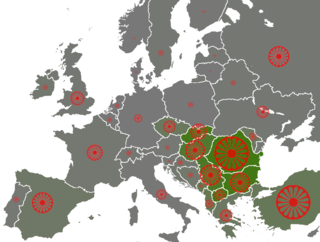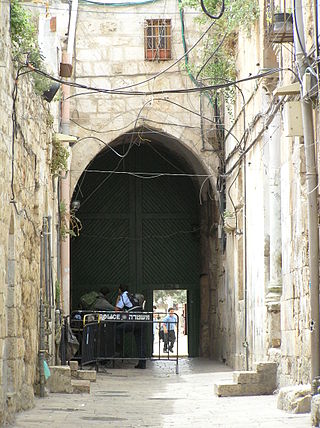Related Research Articles

The Romani, colloquially known as the Roma, are an Indo-Aryan ethnic group and traditionally nomadic itinerants. They live in Europe and Anatolia, and have diaspora populations located worldwide with significant concentrations in the Americas.
The Dom are descendants of the Dom with origins in the Indian subcontinent which through ancient migrations are found scattered across Middle East, North Africa, the Eastern Anatolia Region, and parts of the Balkans and Hungary. The traditional language of the Dom is Domari, an endangered Indo-Aryan language, thereby making the Dom an Indo-Aryan ethnic group.
The Kawliya, Qawliya or Awaz, Keche-Hjälp, also known as Zott and Ghorbati, is a community in Iraq of Indian origin, estimated to number over 60,000 people. Today they speak mostly Arabic, while their ethnolect is a mixture of Persian, Kurdish and Turkish, only spoken by the older generations. The largest tribes are the Bu-Baroud, Bu-Swailem, Bu-Helio, Bu-Dakhil, Bu-Akkar, Bu-Murad, Bu-Thanio, Bu-Shati, Al-Farahedah, Al-Mtairat, Bu-Khuzam, Bu-Abd, Bu-Nasif, Bu-Delli and Al-Nawar. Their main occupation is entertainment, and also small trades.

Domari is an endangered Indo-Aryan language, spoken by Dom people scattered across the Middle East and North Africa. The language is reported to be spoken as far north as Azerbaijan and as far south as central Sudan, in Turkey, Iran, Iraq, Palestine, Israel, Jordan, Egypt, Sudan, Libya, Tunisia, Algeria, Morocco, Syria and Lebanon. Based on the systematicity of sound changes, it is known with a fair degree of certainty that the names Domari and Romani derive from the Indo-Aryan word ḍom. However, the Domari and Romani languages do not derive from the same ancestor idiom. Domari derives from an Indo-Aryan language. The Arabs referred to them as Nawar as they were a nomadic people that originally immigrated to the Middle East from the Indian subcontinent.
The Romani people, also referred to as Roma, Sinti or Kale, depending on the sub-group, are an Indo-Aryan ethnic group which primarily lives in Europe. The Romani may have migrated from what is the modern Indian state of Rajasthan, migrating to the northwest around 250 BCE. Their subsequent westward migration, possibly in waves, is now believed to have occurred beginning in about 500 CE. It has also been suggested that emigration from India may have taken place in the context of the raids by Mahmud of Ghazni. As these soldiers were defeated, they were moved west with their families into the Byzantine Empire. The author Ralph Lilley Turner theorised a central Indian origin of Romani followed by a migration to Northwest India as it shares a number of ancient isoglosses with Central Indo-Aryan languages in relation to realization of some sounds of Old Indo-Aryan. This is lent further credence by its sharing exactly the same pattern of northwestern languages such as Kashmiri and Shina through the adoption of oblique enclitic pronouns as person markers. The overall morphology suggests that Romani participated in some of the significant developments leading toward the emergence of New Indo-Aryan languages, thus indicating that the proto-Romani did not leave the Indian subcontinent until late in the second half of the first millennium.
The Garachi, also spelled Karachi or Karaci, are a group of the Dom people living in Azerbaijan and Turkey. Little research has been done on the Garachi, and most of what is known about them is based on the works of the 19th-century Russian scholars Kerope Patkanov and Jean-Marie Chopin.

The Roma people have several distinct populations, the largest being the Roma and the Iberian Calé or Caló, who reached Anatolia and the Balkans in the early 12th century, from a migration out of the Indian subcontinent beginning about 1st century – 2nd century AD. They settled in the areas of present-day Turkey, Greece, Serbia, Romania, Croatia, Moldova, Bulgaria, North Macedonia, Hungary, Albania, Kosovo, Bosnia and Herzegovina, Czech Republic, Slovenia and Slovakia, by order of volume, and Spain. From the Balkans, they migrated throughout Europe and, in the nineteenth and later centuries, to the Americas. The Roma population in the United States is estimated at more than one million.
Nawar is an Arabic term for several nomad communities used primarily in Jordan, Syria, Lebanon, Israel, and Palestine. The term, regarded as derogatory, is used by Arabs for several diverse ethnic groups. They have historically been called "Gypsies", though as a whole they only have economic activities and lifestyle in connection with the Romani. The Dom people are especially known as Nawar.

Xoraxane Roma in Balkan Romani language, are non-Vlax Romani people, who adopted Sunni Islam of Hanafi madhab at the time of the Ottoman Empire. Some of them are Derviş of Sufism belief, and the biggest Tariqa of Jerrahi is located at the largest Arlije and Gurbeti Muslim Roma settlement in Europe in Šuto Orizari, locally called Shutka in North Macedonia have their own Romani Imamand the Muslim Roma in Šuto Orizari use the Quran in Balkan Romani language. Many Romanlar in Turkey, are members of the Hindiler Tekkesi a Qadiriyya-Tariqa, founded in 1738 by the Indian Muslim Sheykh Seyfullah Efendi El Hindi in Selamsız.

Bilal is a Lebanese singer of Nawari descent, who is notable for singing not only in Arabic, but mainly in Domari, his native language.
Zott is the Arabic term for gypsies, Romani people, and Dom people. The Zott were musicians who migrated in great numbers from northern India to the Middle East about 1000 years ago. Their name was later applied to any itinerant entertainer of Indian origin; and came to be the common name of the Dom people in the Middle East, as English gypsy or tinker with contemptuous connotations. The Al-Qamus Al-Muhit glosses the term as equivalent to Nawar. "Zutt" is also a Arabicised form of Jats.

The ethnic groups in the Middle East in the 'transcontinental' region commonly known with its geopolitical term; the Middle East which includes Western Asia and areas close to West Asia such as Egypt and Cyprus. The region has historically been a crossroad of different cultures and languages. Since the 1960s, the changes in political and economic factors have significantly altered the ethnic composition of groups in the region. While some ethnic groups have been present in the region for millennia, others have arrived fairly recently through immigration. The largest socioethnic groups in the region are Arabs, Kurds, Persians, Turks and Azerbaijanis but there are dozens of other ethnic groups which have hundreds of thousands, if not millions, of members.

The Romani people are also known by a variety of other names; in English as gypsies or gipsies, and Roma; in Greek as γύφτοι (gíftoi) or τσιγγάνοι (tsiggánoi), in Central and Eastern Europe as Tsingani ; in France as gitans besides the dated terms bohémiens and manouches; in Italy as rom and sinti besides the dated terms zingari, zigani, and gitani; in Spain as gitanos; and in Portugal as ciganos.

Bāb Ḥuṭṭa is a neighborhood in the Muslim Quarter of the Old City of Jerusalem to the north of the Haram al-Sharif. The name literally means "Forgiveness Gate", referring to the Remission Gate of the Haram compound, connected by Bāb Ḥuṭṭa Street.
The Domari-speaking community in Syria, commonly identified as Dom and Nawar, is estimated to number 100–250,000 or 250–300,000 people. The vast majority is sedentary. There are semi-nomadic groups, some moving outside the country. In Aleppo, the Dom community is probably the largest, while they are reported to live in Damascus, Homs and Latakia as well. The community is highly marginalised in society, and they are referred to as Qurbāṭ and Qarač in the northern part, and Nawar elsewhere. These terms are used for various groups that mainly share socio-economic profile. The community is divided into clans.
Doms in Libya speak the Domari language. They immigrated to the territory of the present day Libya from South Asia, particularly from India, in Byzantine times. people self-segregated themselves for centuries from the dominant culture of Libya. Historically, Gypsies in Libya have provided musical entertainment as weddings and other celebrations. The Dom people in Libya include subgroups like Nawar, Halebi and Ghagar.
Dom people or "Ghagar" migrated during the Roman era to the territory of the present day Egypt from South Asia, particularly from Indian Subcontinent, and heavily intermixed with Egyptians. Scholars suggest that their Egyptian admixture later made them known around the world by the short term Gypsy, a short for Egyptian. Though some of the Dom people self-segregated themselves for centuries from the dominant culture of Egypt, historically; Domari in Egypt have intermixed with Egyptians and participated at local musical entertainment at weddings, boy islamic circumcision and other celebrations, singing Egyptian traditional songs and dance in return for money. The Dom people in Egypt or Roma Egyptians include subgroups like Nawar, and Ghagar (ghaggar). The Dom in Egypt are Sunni Muslims and speak Egyptian Arabic also their own Domari language together.
Some reports suggest the existence of Romani people in Morocco. Thomas (2000) states that "Xoraxane or Muslim Gypsies have been reported in Morocco. It is suspected that Kalo Gypsies from Spain have migrated to Morocco for business reasons. However no government statistics can substantiate this supposition. Similarly, it may be true that French speaking Gypsies or Manouche may have in the past or still today traveled and worked in Morocco but there is no evidence of this at the moment." Phillips (2001) mentions rather speculatively that "Some Kali or Gitan are probably in Morocco." The available reports are not sufficiently precise to confirm the Romani identity or even existence of such groups, but if they exist and are of Romani origin, then they would have immigrated to the territory of the present day Morocco ultimately from South Asia, and proximately from Spain and/or Algeria.
Romani people in Algeria historically included Gitanos who migrated there along with other Spanish people in the late 19th century, during the French colonial period; most of these left for France following Algeria's independence in 1962, resulting in a large community in the South of France. Ratcliffe (1933) describes a Gitano encampment on the heights above Algiers, whose Catholic inhabitants sold lace and mended chairs. Notable descendants of the Gitanos who used to live in Algeria include the film-maker Tony Gatlif and the footballer André-Pierre Gignac.
Doms in Tunisia speak the Domari language. They immigrated to the territory of the present day Tunisia from South Asia, particularly from India, in Byzantine times. Dom and Nawar people self-segregated themselves for centuries from the dominant culture of Tunisia, who view Romani as dishonorable though clever. Historically, Gypsies in Tunisia have provided musical entertainment as weddings and other celebrations. The Romani people or Gypsies in Tunisia include subgroups like Nawar, Halebi and Ghagar.
References
- ↑ Peoples on the Move: Introducing the Nomads of the World. By David J. Phillips
- ↑ Berland, Joseph C. (2004). Customary Strangers: New Perspectives on Peripatetic Peoples in the Middle East, Africa, and Asia. Westport, Connecticut: Praeger Publishers. ISBN 0-89789-771-4 . Retrieved 2013-10-28.